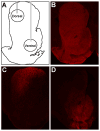Contributions of striatal dopamine signaling to the modulation of cognitive flexibility
- PMID: 21074144
- PMCID: PMC3120097
- DOI: 10.1016/j.biopsych.2010.09.033
Contributions of striatal dopamine signaling to the modulation of cognitive flexibility
Abstract
Background: Although cognitive flexibility is mediated by different areas of the prefrontal cortex, evidence from patients with Parkinson's disease suggests an additional involvement of striatal dopamine (DA) signaling. Because both dorsal and ventral striatum receive prefrontal cortex projections, it is unclear whether DA signaling to either one or both of these regions is required for cognitive flexibility.
Methods: Cognitive flexibility was examined with a water U-maze paradigm in which mice had to shift from an initially acquired escape strategy to a new strategy or to reverse the initially learned strategy. We tested mice with conditionally inactive tyrosine hydroxylase genes that can be activated by Cre recombinase. With region-specific viral gene therapy we selectively restricted DA signaling to either dorsal or ventral striatum.
Results: Restricting DA signaling to the ventral striatum did not impair learning of the initial strategy or reversal-learning but strongly disrupted strategy-shifting. In contrast, mice with DA signaling restricted to the dorsal striatum had intact learning of the initial strategy, reversal-learning, and strategy-shifting.
Conclusions: Dopamine signaling in both dorsal and ventral striatum is sufficient for reversal-learning, whereas only DA signaling in the dorsal striatum is sufficient for the more demanding strategy-shifting task.
Copyright © 2011 Society of Biological Psychiatry. Published by Elsevier Inc. All rights reserved.
Conflict of interest statement
All authors report no biomedical financial interests or potential conflicts of interest.
Figures


Similar articles
-
Restricting dopaminergic signaling to either dorsolateral or medial striatum facilitates cognition.J Neurosci. 2010 Jan 20;30(3):1158-65. doi: 10.1523/JNEUROSCI.4576-09.2010. J Neurosci. 2010. PMID: 20089924 Free PMC article.
-
Requirement of dopamine signaling in the amygdala and striatum for learning and maintenance of a conditioned avoidance response.Learn Mem. 2011 Feb 16;18(3):136-43. doi: 10.1101/lm.2041211. Print 2011 Mar. Learn Mem. 2011. PMID: 21325435 Free PMC article.
-
Contributions of signaling by dopamine neurons in dorsal striatum to cognitive behaviors corresponding to those observed in Parkinson's disease.Neurobiol Dis. 2014 May;65:112-23. doi: 10.1016/j.nbd.2014.01.017. Epub 2014 Feb 1. Neurobiol Dis. 2014. PMID: 24491966 Free PMC article.
-
Inverted-U-shaped dopamine actions on human working memory and cognitive control.Biol Psychiatry. 2011 Jun 15;69(12):e113-25. doi: 10.1016/j.biopsych.2011.03.028. Epub 2011 May 4. Biol Psychiatry. 2011. PMID: 21531388 Free PMC article. Review.
-
Dopamine signaling in the dorsal striatum is essential for motivated behaviors: lessons from dopamine-deficient mice.Ann N Y Acad Sci. 2008;1129:35-46. doi: 10.1196/annals.1417.003. Ann N Y Acad Sci. 2008. PMID: 18591467 Free PMC article. Review.
Cited by
-
Medial Prefrontal Cortex to Medial Septum Pathway Activation Improves Cognitive Flexibility in Rats.Int J Neuropsychopharmacol. 2023 Jun 23;26(6):426-437. doi: 10.1093/ijnp/pyad019. Int J Neuropsychopharmacol. 2023. PMID: 37207293 Free PMC article.
-
Hypnotizability and Catechol-O-Methyltransferase (COMT) polymorphysms in Italians.Front Hum Neurosci. 2014 Jan 6;7:929. doi: 10.3389/fnhum.2013.00929. eCollection 2014 Jan 6. Front Hum Neurosci. 2014. PMID: 24431998 Free PMC article.
-
Tsc1-mTORC1 signaling controls striatal dopamine release and cognitive flexibility.Nat Commun. 2019 Nov 28;10(1):5426. doi: 10.1038/s41467-019-13396-8. Nat Commun. 2019. PMID: 31780742 Free PMC article.
-
Dopaminergic control of cognitive flexibility in humans and animals.Front Neurosci. 2013 Nov 5;7:201. doi: 10.3389/fnins.2013.00201. Front Neurosci. 2013. PMID: 24204329 Free PMC article. Review.
-
Conditional deletion of Ndufs4 in dopaminergic neurons promotes Parkinson's disease-like non-motor symptoms without loss of dopamine neurons.Sci Rep. 2017 Mar 22;7:44989. doi: 10.1038/srep44989. Sci Rep. 2017. PMID: 28327638 Free PMC article.
References
Publication types
MeSH terms
Substances
Grants and funding
LinkOut - more resources
Full Text Sources

